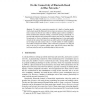Free Online Productivity Tools
i2Speak
i2Symbol
i2OCR
iTex2Img
iWeb2Print
iWeb2Shot
i2Type
iPdf2Split
iPdf2Merge
i2Bopomofo
i2Arabic
i2Style
i2Image
i2PDF
iLatex2Rtf
Sci2ools
EUROPAR
2007
Springer
2007
Springer
On the Connectivity of Bluetooth-Based Ad Hoc Networks
We study the connectivity properties of a family of random graphs which closely model the Bluetooth’s device discovery process, where each device tries to connect to other devices within its visibility range in order to establish reliable communication channels yielding a connected topology. Specifically, we provide both analytical and experimental evidence that when the visibility range of each node (i.e., device) is limited to a vanishing function of n, the total number of nodes in the system, full connectivity can still be achieved with high probability by letting each node connect only to a “small” number of visible neighbors. Our results extend previous studies, where connectivity properties were analyzed only for the case of a constant visibility range, and provide evidence that Bluetooth can indeed be used for establishing large ad hoc networks.
| Added | 07 Jun 2010 |
| Updated | 07 Jun 2010 |
| Type | Conference |
| Year | 2007 |
| Where | EUROPAR |
| Authors | Pilu Crescenzi, Carlo Nocentini, Andrea Pietracaprina, Geppino Pucci, Carlo Sandri |
Comments (0)

